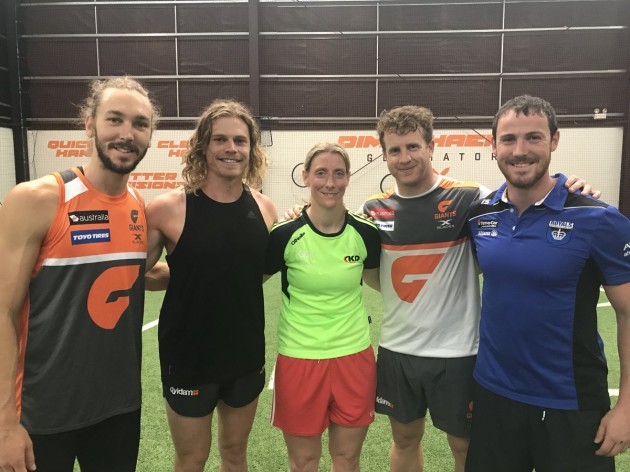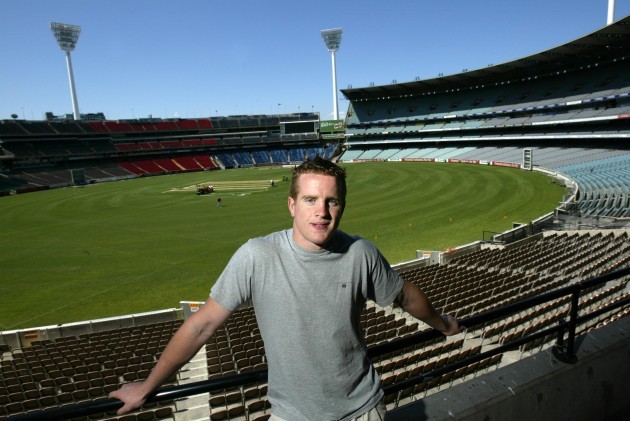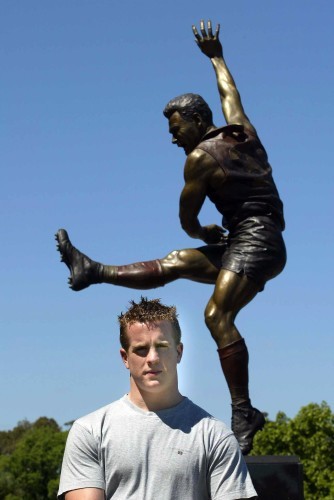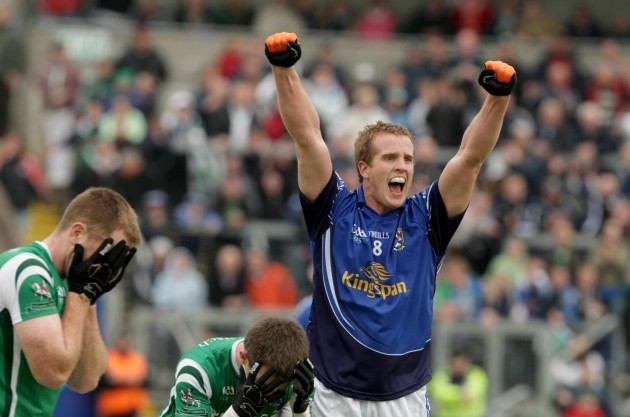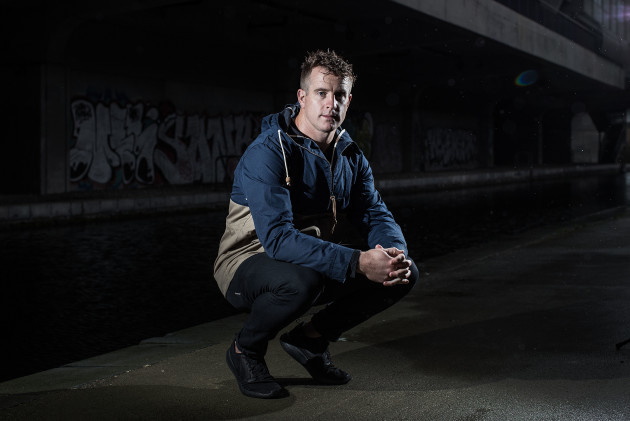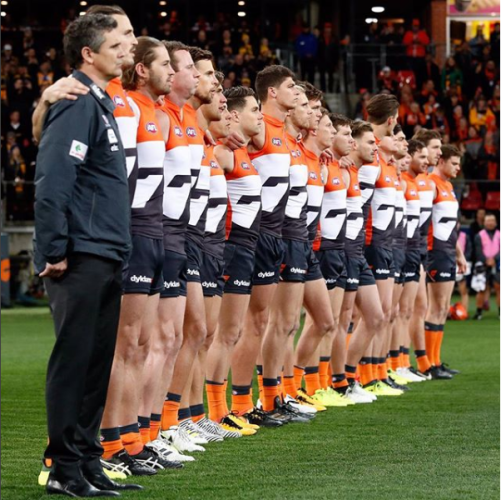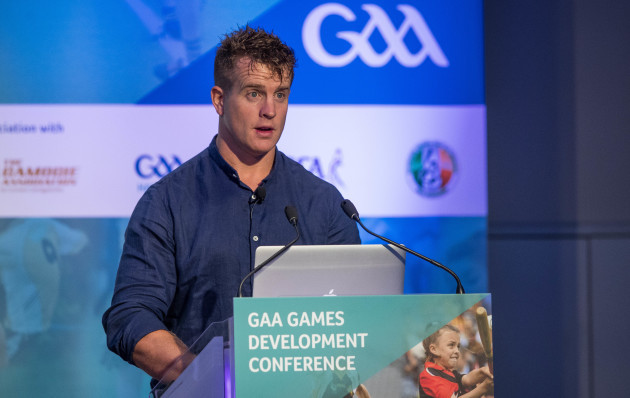IT’S 6.30AM LOCAL time on Saturday morning in Sydney. When Nicholas Walsh picks up the phone he’s already on the road to Sydney Olympic Park, the training facility of the AFL’s newest team.
“It’s sort of a lifestyle thing here – you go to bed early and get up early,” the former Cavan footballer tells The42 as he breezes through the empty streets.
It’s a 25 minute spin from his home to the club’s state of the art training and administration centre. The sun is shining and Walsh optimistic about the day ahead.
The Greater Western Sydney Giants, where he is defence coach, have resumed pre-season training ahead of the 2018 season.
“Normally we’re on the road at half 5, but on Saturday the boys get an extra hour,” he says. A hint of an Aussie twang to Walsh’s accent is evident as he explains what his players have in store for the day.
“We start training at half seven. We’ve got a swim session this morning, it’s like a Saturday conditioning session. It’s much easier to do it at 6.30am in 23 degrees.
“December is the start of the summer so it’s nice. It’s short and singlets every day, it’s that sort of weather.”
The Giants are entering their seventh season in existence as a professional club, and Walsh has been there every step of the way.
They endured a difficult start to life in the AFL in 2012, losing their first game to local rivals the Sydney Swans by 63 points. By the end of their debut season, they set an unwanted AFL record of losing five games by over 100 points.
After winning just two games in their first season in the league, the Giants made it to back-to-back Preliminary finals – the AFL equivalent of All-Ireland semi-finals – in 2016 and 2017.
During that period, Walsh has moved up the ranks from strength and conditioning coach, to player development coach, to defensive coach of the Giants’ reserves team, to his current role as the Giants’ first-team backline coach.
His coaching philosophy is deeply rooted in his past and to a long, winding journey from his native county Cavan. It takes a certain type of unflappable personality to handle moving to Australia as a 17-year-old, battle against persistent injuries for three years before being delisted and return home, broken, at 21, and then spending the next decade honing the skills necessary for another crack at the AFL.
“I was only 17 when I moved there, I hadn’t completed my Leaving Cert,” he says. “There was a camp on in Dublin in September 2000, just after the U17 International Rules that year. When Melbourne Football Club came to the house, looking back it was more a thing I had to do in my own mind.
“Obviously my parents were a bit cautious by the whole fact that I hadn’t completed my school. One of the stipulations was if I was to go, I had to complete my equivalent of my Leaving Cert in Melbourne.
“The person that can either make it as a player or coach here, you have to have some sort of personality and be driven to succeed somehow.”
He recognises now that his young body couldn’t handle the training methods used by the Melbourne Demons almost two decades ago. Walsh spent the guts of three years on a physio table and endured several operations.
While he played over 50 times for the club’s VFL (reserves) team Sandringham, he never made a senior appearance for the Demons. Much of that was down to injuries that could have been avoided.
“Sports science now is different,” he says.
“The injuries I had were pure overload injuries. I had osteo pubis on the groins, it’s not that people don’t get it but it’s easier to detect now.
“People can avoid it by different strength mechanisms and different prehabilitation or rehabilitation. When I went down there in November 2000, I weight something like 80kg.
“I was a really fast responder and I was always naturally strong as a 17-year-old playing in Ireland. So it was a case of the coaching and fitness staff wanting to get as much power and size on me as they could. By Christmas when I came back (to Ireland), in an eight-week period I had put on six or seven kilos, which is a lot of muscle mass really quickly.
“In my belief, that was my downfall. Obviously I was 17 so I was not going to know, and I was going to push myself as hard as possible. That plus I kicked everyday because I wanted to improve my kicking and I had a kicking coach who pushed me to kick.
“You’ve got a kicking coach pushing you to kick maybe 200 kicks a day, plus your strength coach is trying to put on as much muscle mass as possible. I’m talking squatting heavy loads, doing weighted chin-ups on top of all your running, it was totally different.
“Whereas now – the draft was on here last night and our draft players were in on Monday – and they’ll only do 60% of the total preseason. So you see the difference. That’s in easy, layman’s terms. The science behind it is different.”
Right before he returned home on a pre-planned holiday in November 2003, Walsh was confronted with the cutthroat nature of professional sport. Under the promise of a year extension to his contract, he was unexpectedly delisted by the club right before his trip back to Ireland.
“As a professional sports business I just had to accept it. I was ready to come home at that stage because I had a year and a half of on and off injuries of hips, groins and shoulders. I was just after having groin surgery and I had six weeks of rehab ahead of me.
“It was a little difficult I guess, but at the time I had great people around.”
Once he recovered from the groin operation, Eamon Coleman and the Cavan senior footballers offered a welcome on-field distraction. He made his debut in the McKenna Cup against Donegal in Ballyshannon the following January, the beginning of a seven-year inter-county career.
“It was one of the highlights of my sporting career,” he says of his debut. “Jason Reilly kicking a point where he soccer-kicked it off the ground from the end line outside the left boot and it freezing cold in the first week of January.
“I would have grown up in awe of Jason Reilly, Larry Reilly and these sort of boys after winning the Ulster title with Cavan in 1997. Dermot McCabe was playing. It was that childhood dream, then you go away and you go, ‘I’m part of this now.’”
Away from the pitch, Walsh ran a pub in Cavan town before he eventually found his true calling. The sting of his severe injury struggles in Australia never left him and it led him down the path of sports science.
“I did a part-time foundation degree in sports coaching in Jordanstown. I wanted to get into sports science. I wanted to get into the reasons my injuries happened.
“I’ve a love and passion for developing younger players, steering them in the right direction and coaching them. I’ve had that since I left Australia.”
If he hadn’t have struggled with injuries so badly during his spell with the Demons, there’s every chance Walsh wouldn’t have pursued sports science in an effort to prevent future players making the same mistakes he did.
He may not have experienced coaching in Cavan for five years, or landed a dream job in Croke Park as national manager for children in the GAA.
Walsh’s story shows how hard work, putting yourself out there and being in the right place at the right time can open up unexpected possibilities. All the while he was cutting his coaching teeth in Ireland, his thirst for knowledge led him back to Australia in the off-season.
“I never in my mind thought I’d be back coaching professionally in Australia. I said to myself, ‘How am I going to better myself in terms of what’s being done from a strength and conditioning, sports science and a coaching point of view?’
“I looked to Australia because I knew people there, I knew AFL was the closest sport to Gaelic football and obviously the weather is amazing here in December. For two or three weeks I used to come here in the month of December because I never used to take holidays during the year.
“You’d go from courses in January and February into all these different blitzes, Easter camps, summer camps, development squads and school football throughout the year – and playing with Cavan and Cavan Gaels. It was always busy and when December used to come I’d go, ‘I need a break.’ So I used to just go to Australia.”
And so he did. For seven straight years between 2004 and 2010, Walsh travelled Down Under out of his own pocket and built up a vast network of contacts in the process.
“There’s a guy in Melbourne, he’s like my second father, Jim Keogh. He housed me in Melbourne when I lived there. I used to go to visit him and through my contacts in football I’d go and spend a day in Collingwood, in St Kilda and different clubs just through the people I knew.
“Marty Clarke and Kevin Dyas were at Collingwood when I popped down there for a couple of days. I didn’t know them before that and then I got to know them. I remember later on Zach Tuohy was in Carlton when I popped in there for a day and a half because I knew Steve Silvagni who used to play with them. That network just continues.
“There was a couple of people involved in the Melbourne Football Club when I was there. Later on they were involved in the Giants in recruitment. I became good friends with Craig Lambert and (Graeme) ‘Gubby’ Allan who were working at Brisbane at the time.
“They had recruited a couple of Irish players over and I went to Brisbane when Colm Begley was there. That’s where I met Begley for the first time and Brendan Quigley too. It’s bizarre because I know Begs really well know because of my International Rules involvement.”
In December 2010 it was announced that Team GWS were going to have a team in the AFL in time for the 2012 season. The following August, Walsh was on holidays in New York when a call came through from his old friend Gubby Allan. Allan and John Quinn, the high performance manager of the Giants at the time, were down in Florida on important club business.
“I knew the team was being set-up but not once did we speak about the job,” continues Walsh. “He used to pick my brains about a few things about Ireland, coaching and development.
“They flew me down to Tallahassee (in Florida) where his son was studying in Florida State University. They were down there on a fact-finding mission to see what it would be like to set-up the Giants from a university point of view where everyone would live on a little campus.
“I met Gubby and Quinny there in August and they invited me out to Sydney in December just to come out and see what they’re doing. When I went out there that December, they started talking about a potential position.”
Having played a key role in bringing through many of Cavan’s Ulster U21 four-in-a-row-winning players, the Giants identified Walsh as an ideal man to work with their youthful roster.
“They wanted someone from a development point of view that was able to pull people together and that’s worked with kids. I’d worked with 14, 15 and 16 year-olds for the last five years at this stage.
“I was working in a high-performance set-up, say like Cavan for example. The Cavan U21s were starting to come through. Australians aren’t silly, they look at this stuff they don’t just go and pick blindly.
“That’s how it came up. They said there was a position here in strength and conditioning if I wanted it with a view to transitioning to development and potentially coaching.
“I was like, ‘Jesus.’ I had just got a job with the GAA in Croke Park, which was a dream as well. I had a couple of big decisions to make so I had to make them. I made the decision the following September. I was a year working with the GAA and then I went over in October 2011.
“It was through people and different things like that. You when you don’t expect something and then it happens, that’s the way it sort of ends up being. It was really bizarre.”
The Giants navigated early land mines and heavy losses. Walsh and the team management continued to preach that the early years were all about seeing progress and development.
“The structure we had in place, we knew it was going to take three or four years to start breaking through,” he says.
“That was always communicated to our staff, but never to our players because we used to protect the players. We used to say, ‘Let’s just ride this wave. Let’s just continue on the preparation of getting better.’
“We would go down the route where we were developing players rather than coaching them to win for a three years period.
“It was the fact that we were doing extra strength, skills and weight sessions throughout the week to develop their engines quicker, to get their skills and first touch up, and to make them stronger athletes in a mindfulness way, not in a silly way.”
The losses piled up and the growing pains were severe at times, but the Giants had a clear vision of where they were going.
“From there we knew we would potentially get some hammerings – and there were some really, really bad ones. But from a welfare and cultural point of view, some Mondays we didn’t even review the game we just went and did something fun. These boys were 18, 19, 20 years-olds at the time.
“You know what guys those ages are like, they move on very quickly. You’ve got to move things on really quickly because you play each week. You play 22 weeks straight with a week off in between so it’s not like they weren’t moving onto something next week straight away.
“They hurt over that time as well and there was a lot of lessons learned, but we as a coaching group and all round staff had to keep really positive in terms of the approach we want to take and where we wanted to get to.”
The franchise continues to move in rhythm with their overall vision. The Giants eventually established themselves as one of the AFL’s elite sides and head into the 2018 campaign ranked as third favourites to win the Premiership.
It’s not just the men’s team who have felt the benefit of having Walsh around the club.
The Giants established a female side for the inaugural AFL Women’s season in 2017, but they endured a difficult first campaign and finished bottom of the eight-team league.
Walsh and Mayo ladies footballer Cora Staunton had a chance meeting at the Asian Games in Shanghai the previous November, when she peppered him with questions about the new women’s league.
In a post-season debrief this September, the Giants’ women management team identified a lack of leadership as a major reason for their poor campaign. A lightbulb went off in Walsh’s head and he pitched the idea of bringing over Staunton to the management.
In the middle of October, the ladies football legend put pen-to-paper on a deal with the Giants.
“Cora’s football speaks for itself in Ireland and everyone knows her record and that sort of stuff,” he explains. “Cora’s personality was what attracted me to her in terms of a lightbulb going off in my head saying, ‘She may potentially help our women’s football team.’
“Because she’s a great girl, she’s so modest, her personality and drive to excel is phenomenal. She’s got a really, really steely mindset. We’ve got a women’s group that are in their second year in the competition, that are a young group.
@duckie15 massive improvement in only 3 days. Looking for to Cora’s journey in @aflwomens with us at @GWSGIANTS #workinprogess #GAA #AFLW pic.twitter.com/Q50KrIhEjf
— Nicholas Walsh (@nickowalsh) October 20, 2017
“They’re getting better in terms of training standards and what Cora will bring to the group is that personality, that leadership, that drive and training standards. That’s what she’ll really be bringing I believe anyway.
“The football is going to be secondary to all this. Whether Cora makes it on the field, I believe she will if we can get her the ball, but there’s going to be a lot of work for her to do on her kicking and learning the structures of this game in a really, really short space of time.
“When she came over for a week in October, the impact she made in the club in that time, people were like, ‘Jeez, what a great girl.’ She’s a perfect fit for the values we have at our football club and that’s one of the reasons why Alan McConnell our coach wanted to sign her up.”
The42 has just published its first book, Behind The Lines, a collection of some of the year’s best sports stories. Pick up your copy in Eason’s, or order it here today (€10):
